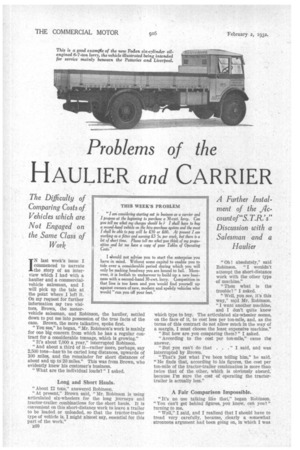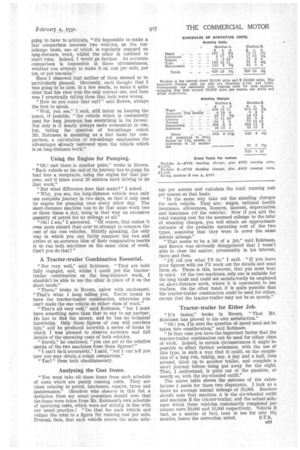Problems of the HAULIER and CARRIER
Page 118

Page 119

If you've noticed an error in this article please click here to report it so we can fix it.
The Difficulty of Comparing Costs of Vehicles which are Not Engaged on the Same Class of Work A Further Instalment of the Account of"S.T.R.' s'' Discussion with a Salesman and a Haulier
IN last week's issue I commenced to narrate the story of an interview whic,h I had with a haulier and a commercialvehicle salesman, and I will pick up the tale at the point where I left it. On my request for further information my two visitors, Brown, the motorvehicle salesman, and Robinson, the haulier, settled down to put me into possession of the true facts of the case. Brown, the more talkative, spoke first.
"You see," he began, "Mr. Robinson's work is mainly. for one big concern from which he has a regular contract for .a considerable tonnage, which is growing." "It's about 7,000 a year," interrupted Robinson.
"And about a third of it—rather more, perhaps, say 2,500 tons—has.to be carted long distances, upwards of 100 miles, and the remainder for short distances of about and up to 20 miles." This was from Brown, who evidently knew his customer's business.
"What are the individual loads?" I asked.
Long and Short Hauls.
" About 12 tons," answered Robinson.
" At present," Brown said, "Mr. Robinson is using articulated six-wheelers for the long journeys and tractor-trailer combinations for the short hauls. It is convenient on this short-distance work to leave a trailer to be loaded or unloaded, so that the tractor-trailer type of vehicle is, I might almost say, essential for this part of the work."
EGO "Oh absolutely," said Robinson. "I wouldn't attempt the short-distance work with the other type of machine."
"Then what is the trouble?" I asked.
"Well, you see, it's this way," said Mr. Robinson. "I want another machine, and I don't quite know which type to buy. The articulated six-wheeler seems, on the face of it, to cost less per ton-mile, and, as the terms of this contract do not allow much in the way of a margin, I must choose the least expensive machine."
"But how are you comparing them?" I asked.
"According to the cost per ton-mile," came thq answer.
"But you can't do that . . " I said, and was interrupted by Brown. "That's just what I've been telling him," he said. "He finds that, according to his figures, the cost per ton-mile of the tractor-trailer combination is more than twice that of the other, which is obviously absurd, ijecause I'm sure the cost of operating the tractortrailer is actually less."
A Fair Comparison Impossible.
"It's no use talking like that," began Robinson. "You can't get behind figures, you know, can you?" turning to me.
" Well," I said, and I realized that I should have to tread very carefully, because, clearly a somewhat strenuous argument had been going on, in which I was going to have to arbitrate, "It's impassible to make a fair comparison between two vehicles, on the tonmileage basis, one of which is regularly engaged on long-distance Work, whilst the other is confined to short runs. Indeed, I would go farther. An accurate comparison is impossible in those circumstances, whether you attempt to make it on cost per mile, per ton, or per ton-mile."
Here I observed that neither of them seemed to be particularly pleased. Obviously, each thought that I was going to be able, in a few words, to make it quite clear that his view was the only correct one, and here was I practically telling them that both were wrong.
"How do you make that out?" said Brown, always the first to speak.
"Well, you see," said, still intent on keeping the peace, if possible, "the vehicle which is consistently used for long journeys has everything in its favour. Not only is it nearly always more economical to rim, but, taking the question of ton-mileage which Mr. Robinson is assuming as a fair basis for comparison, a calculation of ton-mileage emphasizes the advantages already bestowed upon the vehicle which is on long-distance work."
Using the Engine for Pumping.
" Oh ! and there is another point," broke in Brown. "Each vehicle at the end of its journey has to pump its load into a receptacle, using the engine for that purpose, and it takes about 20 minutes hard driving to do that work."
"But what difference does that make?" I asked.
"Why, you see, the long-distance vehicle does only one complete journey in two days, so that it only uses its engine for pumping once every other day. The short-distance machine has to do that sank work two or three times a day, using in that way an excessive quantity of petrol for no mileage at all."
"Oh I I see," I answered. "Of course, that makes it even more absurd than ever to attempt to compare the cost of the two vehicles. Strictly speaking, the only way in which you can fairly compare the two and arrive at an accurate idea of their comparative merits is to run both machines on the same class of work. Can't you do that?"
A Tractor-trailer Combination Essential.
"Not very well," said Robinson. "They are both fully engaged, and, whilst I could put the tractortrailer combination on the long-distance work, I shouldn't he able to use the other in place of it on the short hauls."
"There," broke in Brown, aglow with excitement. "That's what I keep telling you. You're bound to have the tractor-trailer combination, otherwise you can't make the one vehicle do either class of work."
"That's all very well," said Robinson, "but I must have something more than that to say to my partner. He has to find the money, and he has no technical knowledge. Only these figures of cost will convince him," and he produced herewith a series of books in which I was pleased to observe accurate and full details of the operating costs of both vehicles.
"Surely," he continued, "you can get at the relative merits of the two machines from these figures?"
"I can't do it accurately," I said, "but I can tell you how you may obtain a rough comparison."
" Yes? " from both simultaneously.
Analysing the Cost Items.
"You must take all those items from each schedule of costs which are purely running costs. They are those relating to petrol, lubricants, repairs, tyres and maintenance." (Readers who observe in this list a deviation from my usual procedure should note that the items were taken from Mr. Robinson's own schedule of operating costs, which were not strictly in line with our usual practice.) "Do that for each vehicle and reduce the total to a figure for running cost per mile. Pretend, then, that each vehicle covers the same mile
age per annum and calculate the total running cost per annum on that basis. "In the same way take out the standing charges for each vehicle. They are: wages, national health insurance, allowances, licences, interest, depreciation and insurance (of the vehicle). Now if you add the total running cost for the assumed mileage to the total of standing charges, you will obtain an approximate estimate of the probable operating cost of the two types, assuming that they were to cover the same annual mileage." "That seems to be a bit of a job," said Robinson, and Brown was obviously disappointed that I wasn't able to close the matter, presumably in his interest, there and then.
" tell you what I'll do," I said. "If you leave your figures with me I'll work out the details and send them on. There is this, however, that you must bear in mind. Of the two machines, only one is suitable for the long hauls and could not satisfactorily be employed on short-distance work, where it is convenient to use trailers. On the other hand, it is quite possible that the tractor-trailer combination could be used for either, except that the tractor-trailer may not be so speedy."
Tractor-trailer for Either Job.
"It's faster," broke in Brown. "That Mr. Robinson has proved to his own satisfaction."
"Oh! yes, I'm sure the question of speed need not be taken into consideration," said Robinson.
"In that case you have the important factor that the tractor-trailer combination can be used for either class of work. Indeed, in certain circumstances it might be possible to effect further economies, with the use of this type, in such a way that it could, on the completion of a long run, taking, say, a day and a half, turn around, hitch up to another trailer, and complete a short journey before being put away for the night. That, I understand, is quite out of the question, or nearly so, with the six-wheeled outfit." The above table shows the outcome of the calculations I made for these two disputants. I took as a basis an average annual mileage of 20,000. Readers should note that machine A is the six-wheeled outfit and machine B the tractor-trailer, and the actual mileages which these vehicles customarily completed per annum were 20.000 and 10,000 respectively. Vehicle B had, as a matter of fact, been in use for only 10* months, hence the correction noted. S.T.R.




































































































































































